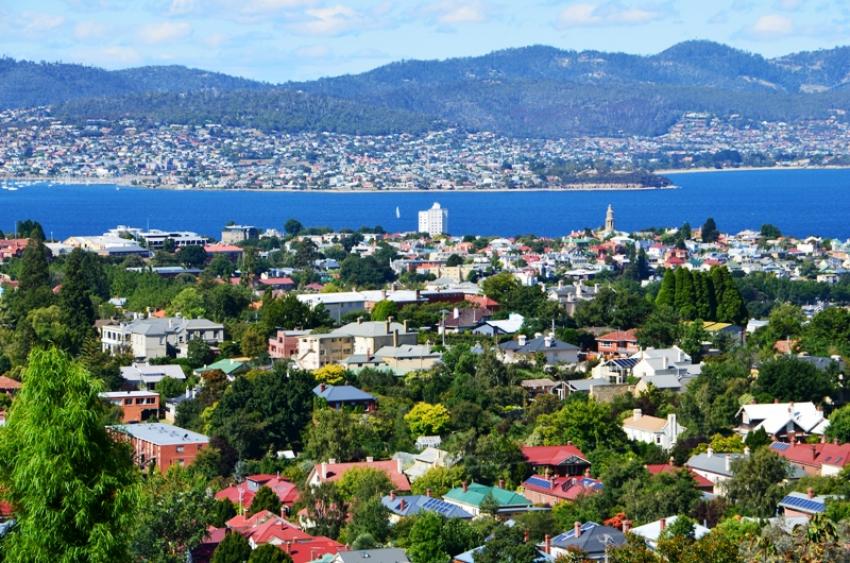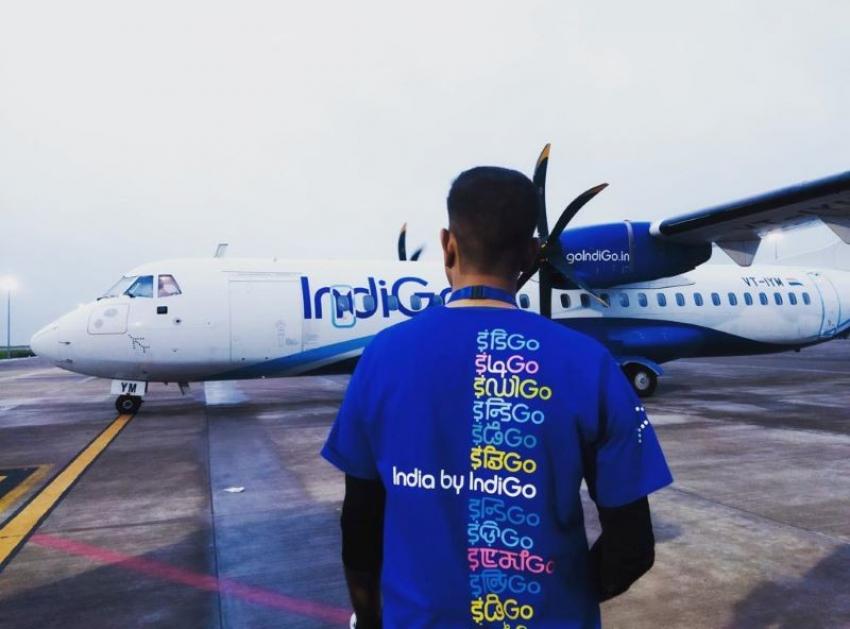Sandip Hor | @notintownlive | 28 Feb 2018, 06:54 am

Tasmania is small but its natural setting offers great diversity. From rugged coastlines and glacial mountains to wild rivers and rolling hills. Sandip Hor is awestruck
“Our land abounds in nature’s gifts of beauty rich and rare”, is a line from Australian national anthem that engage me intimately when travelling Tasmania which like rest of Australia is “girt by sea”.
Yes it’s an island on the southern side of the continent facing Antarctica, just over 7000 km away with nothing in between. So when wind gushes from there, now and then, temperatures drops magically forcing jackets, scarves and beanies out from the backpacks.
Belying its small size, Tasmania’s natural setting like in India, offers great diversity. It varies dramatically with a spread of rugged coastlines, glacial mountains, wild rivers, sprawling lakes, dense forests and endless rolling hills and meadows, often compared to green pastures in England. The flora, fauna and wildlife found here is unique as well. So typical Tasmanian experience can be somewhat different to what visitors’ sense when touring other iconic locations in mainland Australia.
History of the place is no less invigorating.
Though it has been home to indigenous people for over 35000 years, the land first came under European spotlight when Dutch sailor Abel Tasman set his foot here in 1642 and named it Van Diemen’s Land after a Dutch East Indies governor. After the British established Australia as penal colony in 1788, this island at the start of 19th century became the second venue to house colonial convicts. In 1824, the British declared it as a colony, had name changed to Tasmania in 1856 and became a state of Australia during time of federation formation in 1901. There are several locations throughout the state that brings alive this exhilarating history, from maritime adventures and industrials developments to brutal convict life.
State capital Hobart is a key repository of some of this vibrant history. Spread over seven hills between the Derwent Estuary and Mount Wellington, it was established in 1804 and boasts as Australia’s second oldest city after Sydney.
In a world where new is taking over the old, there are many pockets in Hobart where past can be identified in the present. Its magnificent waterfront, dotted with taverns and inns, is still utterly vibrant as it was during the time of whaling and sealing in the early 19th century, the only difference today is presence of more tourist ferries and ocean liners than fishing boats and freighters.
I seize a good dose of history when wander in Hobart around Battery Point, a former maritime enclave packed with elegant 19th century cottages and Salamanca Place where the sandstone warehouses stand as finest examples of Georgian architecture. During colonial times Salamanca Place was the hub of trade and commerce. Similar bustling business atmosphere comes alive here every Saturday when the site becomes a busy market place, selling almost everything from traditional crafts and works of emerging artists, vintage finds and fresh produce to old books , new releases, antique objects, photos and curios . Glimpses of Tasmania's past colonial life can still be seen in some of the market's knife makers, wood turners, metal smiths and jewellers.
There are several buildings in and around Hobart that remind good-old colonial times The Town Hall, Parliament House, St David’s Cathedral and Theatre Royal which is the country’s oldest continuously operating stage are few from the long list that draw attention of all keen on architectural magnificence.
Not all of Tasmania’s history is rosy and glorious, the darker sides are exposed when visit former penal settlements like the one at Port Arthur, located about an hour and half away from Hobart on the scenic Tasman Peninsula. Between 1833 and 1877 it was dubbed as ‘Hell on Earth’ when over 12000 British convicts lived there under constant threat of lash and other extremely harsh punitive treatments. The offence for some of the convicts, who were as young as 20 years, was nothing more than stealing a book or some food to survive. Guided tours are available to take visitors through beautifully restored sandstone buildings and grounds that are filled with compelling stories of convicts and guards.
One such story is of George 'Billy' Hunt who in disguise of a kangaroo attempted escape, but the guards spotted him as a ‘running roo’ and started shooting with a view to kill the animal and then eat its meat. Hunt sensing danger of death threw off his camouflage and surrendered, receiving 150 lashes for his troubles. So it’s very hard to control emotions when hearing many stories like this. I am sure every visitor when here wonders how so much cruelty could crop up in human mind when surrounding nature at the location is so calm, soothing and charming.
Tasmania is a treasure trove of natural wonders. According to experts, the island's stunning landscapes were shaped by previous ice ages and today offers an exceptional diversity from alpine ranges, wetlands, grasslands, gorges and waterfalls to coastal moorlands, tall sea cliffs and vast temperate rainforests. So getting immersed into unspoilt nature is undoubtedly a major drawcard for the region’s tourism. Nature’s generous blessings can be observed almost everywhere in the island, but there are many iconic locations where it’s exceptionally breathtaking and hence included in bucket lists of travel enthusiasts. Wineglass Bay, Cradle Mountain, Dove Lake, Maria Island, Bruny Island, Tasman Peninsula and Strahan are few popular sites that regularly prop up while preparing Tasmania itineraries. When set foot in any of these sites with an open mind, it’s common for people to place Tasmania in the same bracket with destinations like Kashmir and Switzerland as ‘paradise on earth’.
A destination becomes more interesting when accommodation, dining and drinking options are well up to the travellers' expectation. Tasmania doesn’t disappoint anyone in these regard. While a wide range contemporary hotels, motels and backpacker hostels make the stay affordable and comfortable to suit budget and taste, the gourmet scene is spread with cosy pubs, trendy cafes, country styled eateries and high-end fine dining restaurants, serving some of Australia’s finest food and beverage experience.
Finally what makes Tasmania experience different and special is the company of friendly locals, who call themselves ‘Tassis’. They are all ‘Aussies’, but as one of them remarked, “All Aussies’ are not ‘Tassies”.
Travel Notebook
Getting There: Thai Airways (www.thaiairways.com) fly from many Indian cities to Sydney, Melbourne and Brisbane from where Virgin (www.virginaustralia.com), Qantas (www.qantas.com) and Jetstar Airways (www.jetstar.com) have regular flights to Hobart.
Stay: While many options available throughout the state, some notable ones are MACq01 (www.macq01.com.au) in Hobart, Penghana Bed & Breakfast (penghana.com.au) in Queenstown and Cradle Mountain Wilderness Village (www.cradlevillage.com.au) in Cradle Valley.
Eating joints worth trying: Award winning Aloft (www.aloftrestaurant.com), seafood haven Drunken Admiral (drunkenadmiral.com.au) and Indian Restaurant Cinnamon (www.cinnamonig.om.au) in Hobart , country styled Empire Hotel(www.empirehote.net.au) in Queenstown and Hellyers (www.cradlevillage.com.au) in Cradle Mountain.
Some Must Do Experiences
Get a full assault on senses by browsing through some bold and daring art at the famed MONA- Museum of Old and New Art Museum (mona.net.au) in Hobart
Capture breathtaking views of Hobart cityscape from the summit of 1270m tall Mt Wellington (www.wellingtonpark.org.au) which guards the city like a caring overlord.
Puff through deep rainforest aboard a majestic steam train trip offered by West Coast Wilderness Railway (www.wcwr.com.au) from mining town Queenstown.
Cruise along the coastline of Bruny Island (www.brunycruises.com.au), where parts of the movie Lion was filmed, for close encounter with Australia’s tallest sea-cliffs , towering crags, blow holes and deep sea caves while keeping eyes open for abundant sea life including seals, dolphins migrating whales and sea birds.
Create own adventure while walking around Dove Lake (www.discovertasmania.com.au) beautified by the presence of the majestic Cradle Mountain
Meet Tasmanian devils, planet’s largest living carnivorous marsupial unique to Tasmania, at Devils@Cradle (www.devilsatcradle.com) a world class wildlife conservation facility located in the World Heritage listed Cradle Mountain National Park.
Immerse into making and tasting of whisky at Sullivan’s Cove Distillery (sullivanscove.com) , producers of some of best whisky’s in the world
More information – See www.discovertasmania.com.au and www.australia.com
- From Kennedy’s Proposal to 1850s Saloons: The Three Historic D.C. Restaurants Everyone Must Try
- This city has the best bagel in the US, and it’s not New York!
- I escaped to Pachmarhi — what I found in the queen of Satpura left me spellbound
- Air Canada just ranked the Best New Restaurants of 2025 - And the Top Spot isn't who you think
- Rediscovering Arunachal's Monpa Cuisine: One Woman’s Millet Momo Revolution
- Discovering Heritage: A visual journey through Odisha crafts museum Kalabhoomi
- From kebabs to biriyani: Lucknow gets UNESCO honour for its royal cuisine
- Delta takes Spanish flavours to the skies
- Kolkata’s iconic Kathi Roll among world’s top 10 wraps: TasteAtlas
- Yellow Taxis and the Colours of Puja
Air Canada has introduced a new non-stop route connecting Toronto with Rio de Janeiro, with the first flight landing in the Brazilian city on Friday morning.
Air India, India’s leading global airline, and Maldivian, the national airline of the Maldives, have entered a bilateral interline partnership aimed at boosting connectivity between the two countries.
IndiGo, India’s largest airline, is grappling with one of its most severe operational crises in recent years, with widespread flight delays and cancellations disrupting travel across the country for a second consecutive day.

.JPG)
.JPG)
.JPG)
.JPG)




